By: Ted Dabrowski and John Klingner
A collapse in student outcomes
Consensus has increasingly coalesced around the fact that school closures, remote learning and other Covid mitigations during the pandemic have been harmful for children academically, as well as mentally, socially and developmentally. The academic damage done is the focus of this report. As recent results across the country have shown, 20 years or more of progress has been erased during the pandemic.
Unsurprisingly, Illinois students weren’t spared. A Wirepoints analysis of Illinois State Board of Education (ISBE) data comparing pre-Covid 2019 student outcomes versus those in 2021 shows that the number of students able to read at grade level dropped from 37 out of every 100 students – already dismal – to just 31 out of every 100. That’s a drop of 18 percent.*
The results for black students were even worse – a 36 percent decline – with just 11 of every 100 black students able to read at grade level in 2021.
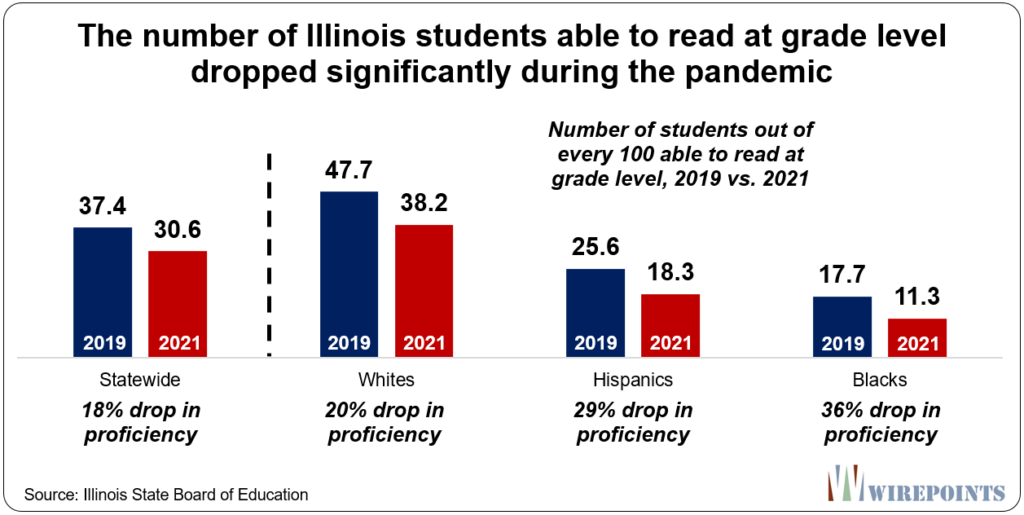 Those declines are depressing considering how poorly Illinois students were performing even before the pandemic. The Wall Street Journal Editorial Board was rendered “speechless” when the editors read Wirepoints’ previous report, “Poor student achievement and near-zero accountability: An indictment of Illinois’ public education system,” that detailed the state’s 2019 results.
Those declines are depressing considering how poorly Illinois students were performing even before the pandemic. The Wall Street Journal Editorial Board was rendered “speechless” when the editors read Wirepoints’ previous report, “Poor student achievement and near-zero accountability: An indictment of Illinois’ public education system,” that detailed the state’s 2019 results.
From the WSJ’s “Illinois’s Shocking Report Card. The Land of Lincoln is failing its children and covering it up”:
Statewide, in 2019, 36% of all third grade students could read at grade level. That’s an F, and that’s the good news. That number drops to 27% for Hispanic students and 22% for black students statewide. In certain public school systems, the numbers plummet to single digits. In Decatur, 2% of black third-graders are reading at grade level and only 1% are doing math at grade level. We aren’t often speechless, but the extent to which that performance is betraying a generation of schoolchildren is hard to put into words.
That further damage was inflicted on student outcomes in 2021 is even more painful.
A cursory glance at the worst performers among the state’s largest school districts shows how dramatic some of the drops have been. Decatur, featured in our first report, saw outcomes collapse further in 2021. Just 6 out of every 100 students in the district could read at grade level. It was 12 before the pandemic.
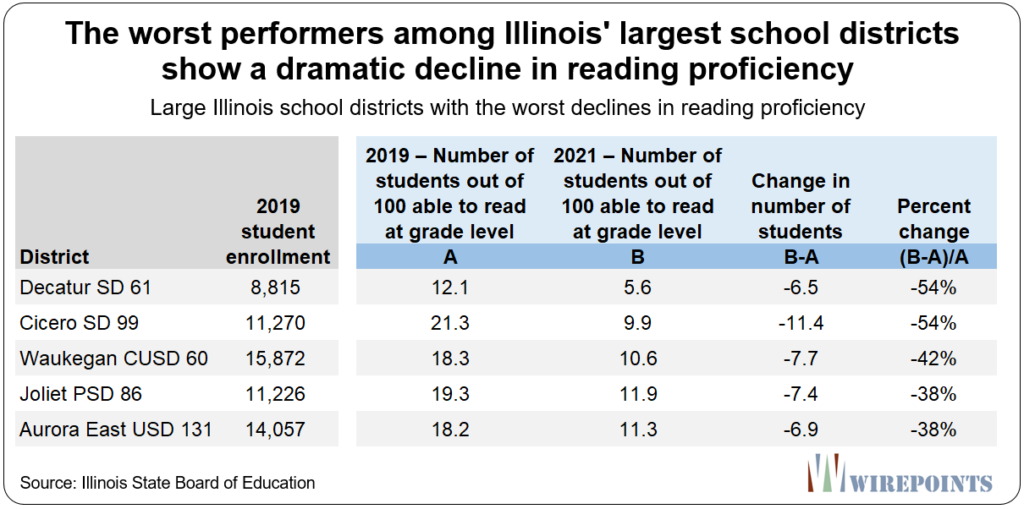 The drop in reading was widespread across the state. Over 60 percent of Illinois’ 850 school districts, or 521 districts, had reading proficiency levels decline by 20 percent or more.
The drop in reading was widespread across the state. Over 60 percent of Illinois’ 850 school districts, or 521 districts, had reading proficiency levels decline by 20 percent or more.
 Illinois student performance in math was just as bad – 61 percent of districts (516 in all) had math proficiency drop by 20 percent or more. The full results for math can be found in the Appendix below.
Illinois student performance in math was just as bad – 61 percent of districts (516 in all) had math proficiency drop by 20 percent or more. The full results for math can be found in the Appendix below.
ISBE is reportedly set to release Illinois’ 2022 student achievement data on October 27. If there is any improvement in student achievement in 2022, it must be put in context with the damage done to students over the 2019-2021 period.
Key Findings
The key findings of Wirepoints’ analysis include the following:
- Reading proficiency in Illinois fell by 18 percent over the past two years. Just 37.4 out of every 100 Illinois students were reading at grade level in 2019; that fell to 30.6 out of every 100 in 2021.
- Math proficiency suffered a 19 percent decline. Just 32 out of every 100 Illinois students were able to do math at grade level in 2019; that fell to 25.8 out of 100 in 2021.
- The drop in proficiency was even larger for minorities. Reading proficiency for Hispanics dropped 29 percent during the pandemic (from 26 students out of 100 to 18), while black student proficiency dropped a dramatic 36 percent (from 18 students out of 100 to 11).
- In 2021, only 38 percent of white students, 18 percent of Hispanic students and just 11 percent of black students statewide were proficient in reading.
- In 2021, only 33 percent of white students, 13 percent of Hispanic students and just 6 percent of black students statewide were proficient in math.
- As a result of all the drops in proficiency, the number of Illinois’ 850 districts that had fewer than 30 percent of their students proficient in reading jumped by 83 percent, from 256 districts in 2019 to 470 districts in 2021.
- Chicago Public Schools students suffered a 20 percent drop in reading proficiency and a 26 percent drop in math proficiency between 2019 and 2021. Just 17 of every 100 Hispanic students and just 11 of every 100 black students in CPS could read at grade level in 2021.
- Despite the collapse in student outcomes, the number of teachers statewide evaluated as “excellent or proficient” rose to 98.8 percent in 2021, up from 97.2 percent in 2019. Every single evaluated teacher was rated “excellent or proficient” in 462 school districts in 2021.
- In Chicago Public Schools, 100 percent of teachers were evaluated as “excellent or proficient” in 2021, up from 91.4 percent in 2019.
Reading proficiency collapses
An overview of the state’s 30 largest school districts, which make up 40 percent of Illinois’ entire student population, paints the overall picture of how reading proficiency collapsed in 2021.
The biggest drop among the largest districts was Decatur (tied with Cicero), which saw its reading proficiency level fall by 54 percent.
That news is particularly disheartening given that before Covid only 12.1 out of every 100 students in the district’s entire 8,400 enrollment could read at grade level. By 2021, just 5.6 students out of 100 were at grade level. The student makeup in the Decatur school district is one-third white, one-half black and 5 percent Hispanic, so the damage hit all students, regardless of race or ethnicity.
 Cicero SD 99, a district overwhelmingly made up of Hispanics (97 percent), also saw proficiency fall by 54 percent. Before Covid, 21.3 students out of every 100 could read at grade level. After the state’s pandemic measures, that fell to just 9.9 out of every 100 students.
Cicero SD 99, a district overwhelmingly made up of Hispanics (97 percent), also saw proficiency fall by 54 percent. Before Covid, 21.3 students out of every 100 could read at grade level. After the state’s pandemic measures, that fell to just 9.9 out of every 100 students.
Waukegan, another large Hispanic district (80 percent), saw its reading proficiency drop 42 percent. Before Covid, 18.3 out of every 100 students were proficient in reading. By 2021, just 10.6 students out of every 100 were proficient.
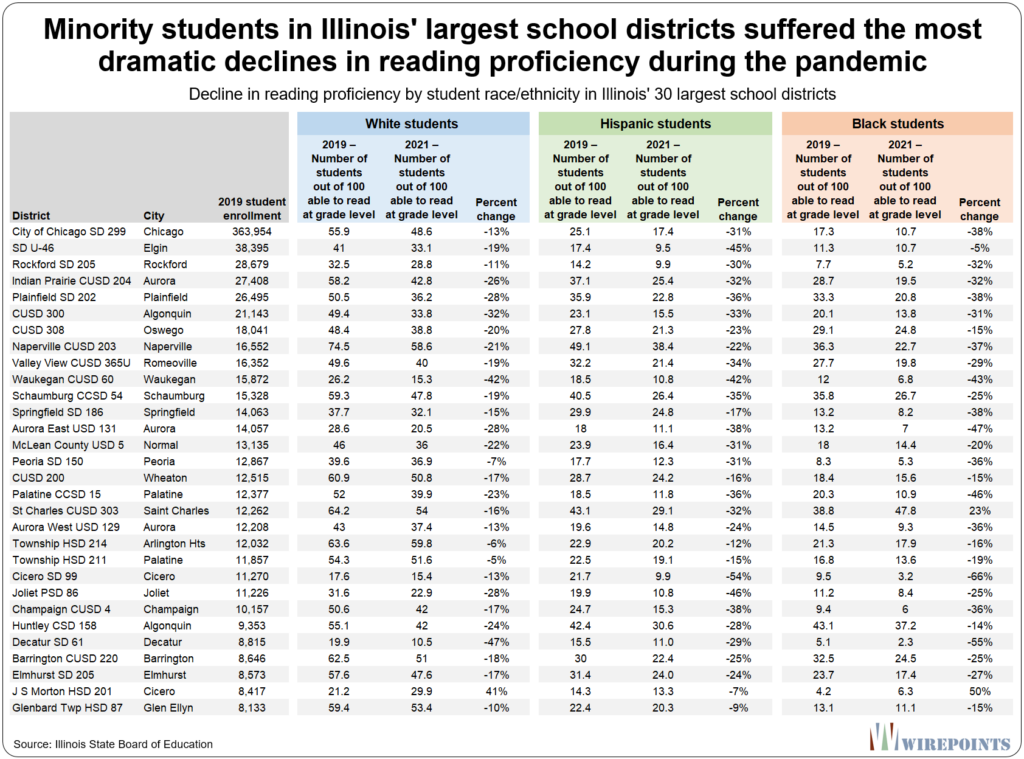 The state’s largest school district, Chicago Public Schools, saw its reading proficiency drop from 27 out of every 100 students to just 21.5 per 100. That’s a 20 percent drop in proficiency.
The state’s largest school district, Chicago Public Schools, saw its reading proficiency drop from 27 out of every 100 students to just 21.5 per 100. That’s a 20 percent drop in proficiency.
White Chicago students experienced a 13 percent drop, Hispanics had a drop of 31 percent and black student reading proficiency dropped 38 percent.
 As a result of all the drops in proficiency, the number of Illinois’ 850 districts that had fewer than 30 percent of its students proficient in reading jumped by 84 percent, from 256 districts in 2019, to 470 districts in 2021.
As a result of all the drops in proficiency, the number of Illinois’ 850 districts that had fewer than 30 percent of its students proficient in reading jumped by 84 percent, from 256 districts in 2019, to 470 districts in 2021.
The number of districts with reading proficiency between 60 and 90 percent dropped from 89 to 40, while the number of districts with 30 to 60 proficiency fell from 505 to just 340.
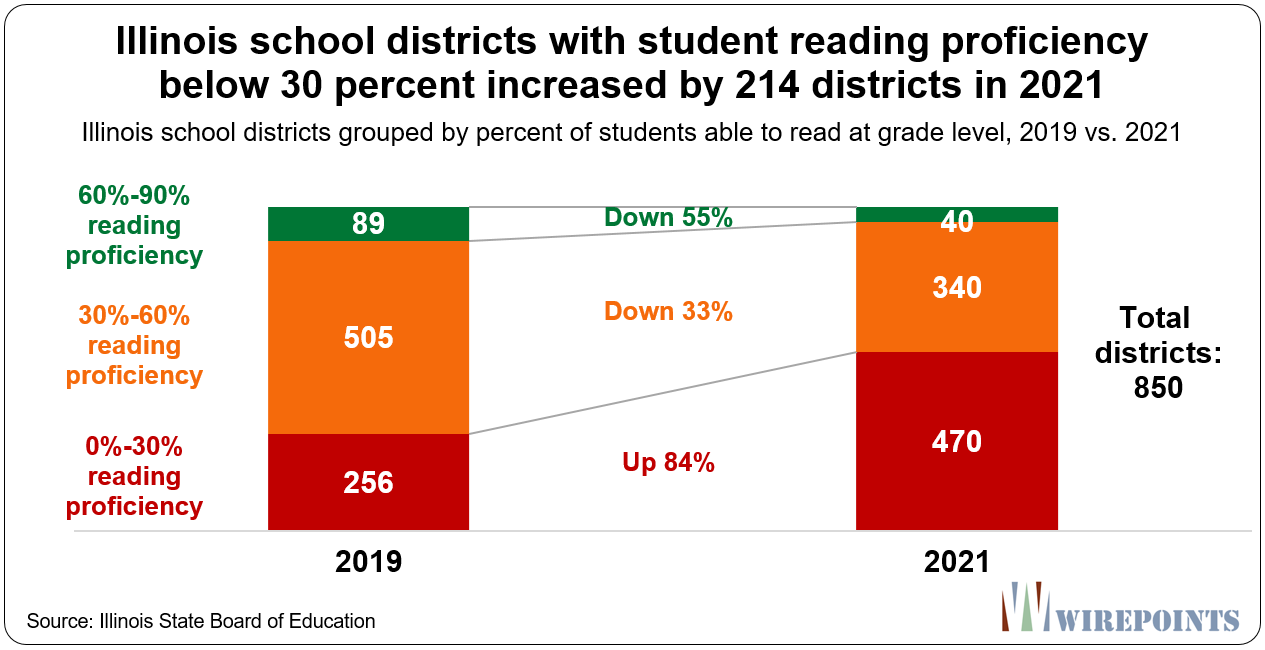 Here’s the full breakdown by 10 percent intervals.
Here’s the full breakdown by 10 percent intervals.
Teacher evaluations
A last subject which deserves attention is the direction in which teacher evaluations moved during Covid. Even before the pandemic, teacher evaluations were already way out-of-sync with student outcomes.
Despite just 37 percent of all Illinois students being able to read at grade level in 2019 (including just 26 percent of Hispanic students and 18 percent of black students), 97.2 percent of teachers were rated “excellent or proficient” that year.
In 2021, regardless of the significant decline in student scores, shutdowns, remote learning, etc., 98.8 percent of teachers were rated “excellent or proficient.” Amazingly, of the 593 school districts that performed teacher evaluations in 2021, 462 districts rated 100 percent of their teachers “excellent or proficient.”
Conclusion
As the above results show, Illinois student outcomes suffered a significant decline. However, the reality is that even before Covid, this state’s education results were dismal.
Look for lawmakers to argue that even more money is needed to improve outcomes. But as we argued in our recent report, money can’t and won’t fix Illinois’ educational-industrial complex:
Today, Illinoisans are stuck with a $38 billion system that demands little to no accountability from its educators. A system that prioritizes social promotion over literacy. A system that’s more obsessed with vague outcomes like equity and diversity than merit and competence. A system that compensates itself handsomely and performs self-serving evaluations, never mind the outcomes. And a system where parents have little to no choice but to send their kids to failing schools.
It’s no wonder so many parents have simply given up fighting or have packed up and left Chicago and other Illinois cities.
Illinois education requires a dramatic transformation. But that won’t happen until the state’s political elite acknowledge the system no longer works for students and parents.
*Please note that Wirepoints uses the phrase “can read or do math at grade level” to describe students who meet Illinois Assessment of Readiness (IAR) “proficiency” standards. This is consistent with the Illinois School Board of Education’s definition of proficient: “Students performing at levels 4 and 5 met or exceeded expectations, have demonstrated readiness for the next grade level/course and, ultimately, are likely on track for college and careers. We also use the “grade level” description above as shorthand for the 11th-grade Scholastic Aptitude Test (SAT) proficiency standards.
Appendix. Illinois’ math results

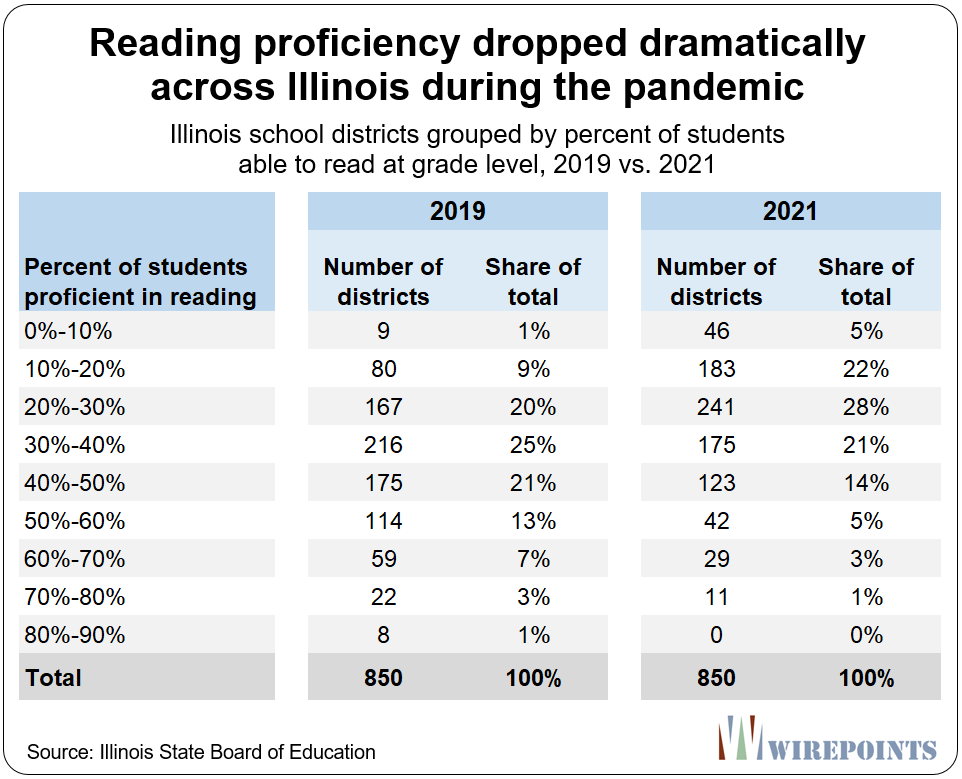
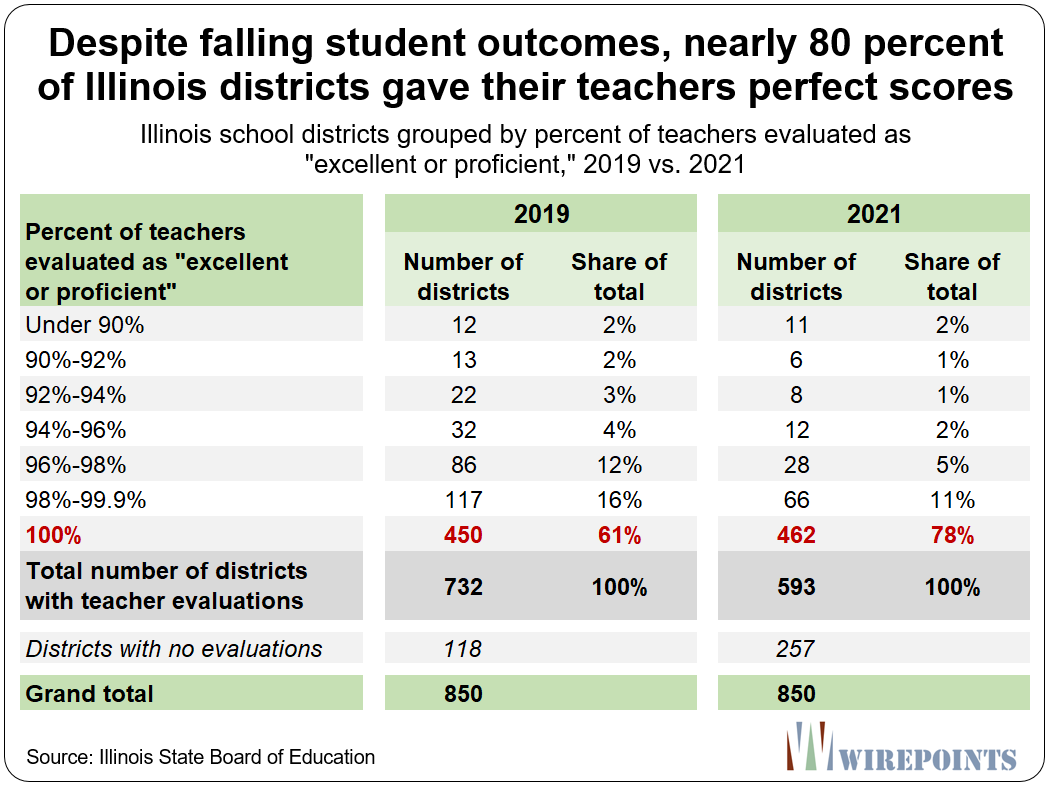



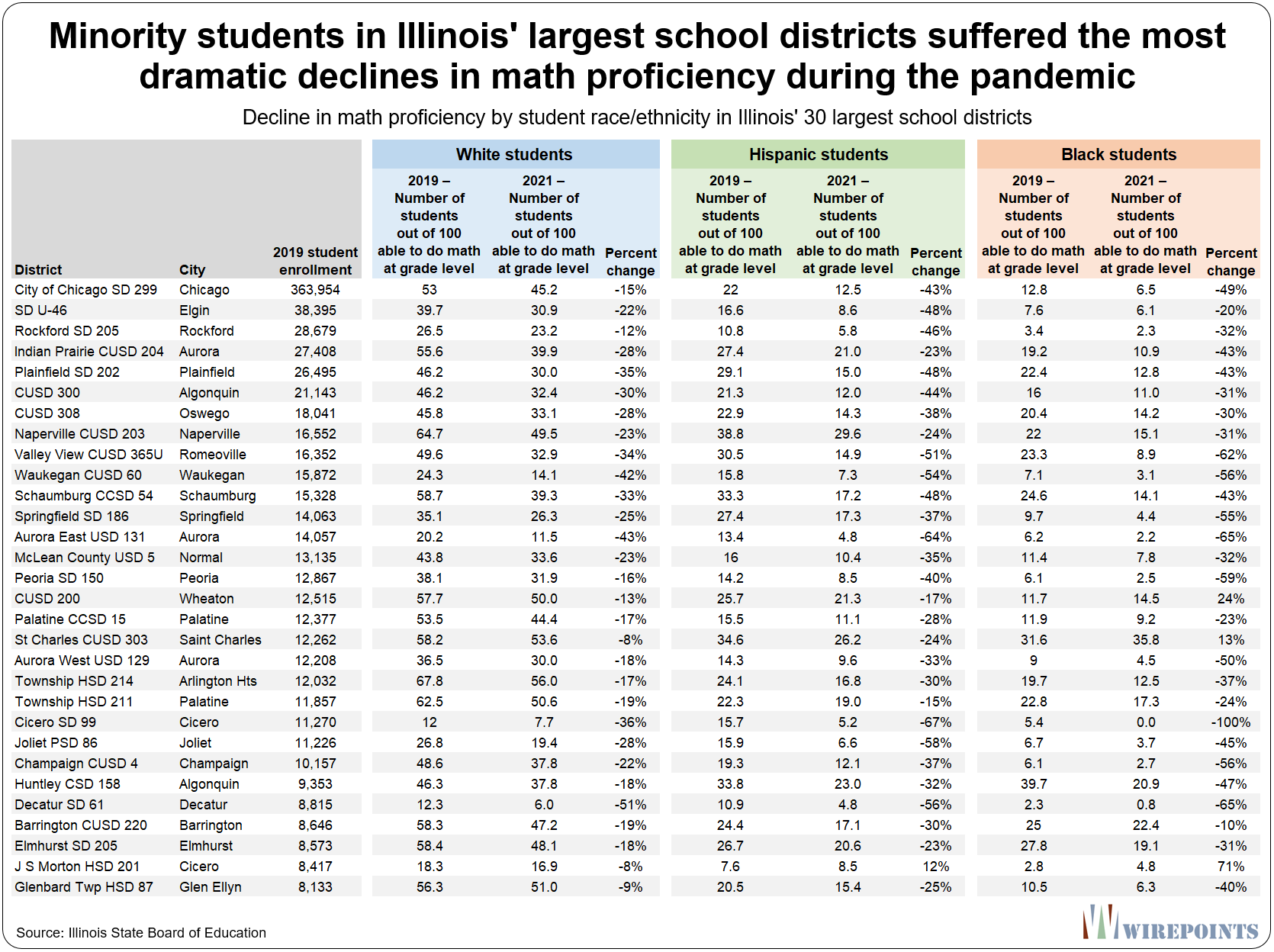
 A set of state lawmakers want to extend CPS’ current school closing moratorium to February 1, 2027 – the same year CPS is set to transition to a fully-elected school board. That means schools like Manley High School, with capacity for more than 1,000 students but enrollment of just 78, can’t be closed for anther three years. The school spends $45,000 per student, but just 2.4% of students read at grade level.
A set of state lawmakers want to extend CPS’ current school closing moratorium to February 1, 2027 – the same year CPS is set to transition to a fully-elected school board. That means schools like Manley High School, with capacity for more than 1,000 students but enrollment of just 78, can’t be closed for anther three years. The school spends $45,000 per student, but just 2.4% of students read at grade level.
 Hopefully, all media will get the message, in Illinois, too.
Hopefully, all media will get the message, in Illinois, too. Ted joined Tom Miller of WJPF to talk about Illinois’ highest-in-the-nation property taxes, why lawmakers don’t want to touch the tax’s cost drivers, just how much Illinoisans’ tax burden has grown over the decades, why Gov. Pritzker failed to meet his promise to reform property taxes, and more.
Ted joined Tom Miller of WJPF to talk about Illinois’ highest-in-the-nation property taxes, why lawmakers don’t want to touch the tax’s cost drivers, just how much Illinoisans’ tax burden has grown over the decades, why Gov. Pritzker failed to meet his promise to reform property taxes, and more.
Only until I get to that last chart do I see any indication of anyone groups other than Blacks and Hispanics. To provide proper context, you should also break out Asian and European Whites because I assume the latter two ethnics are also represented in those same classrooms with Blacks and Hispanics.
They need to break this down by private versus public schools since the private schools didn’t close for the most part.
I have a problem with the first chart, which comes from the Illinois State Board of Education, and purports to show the number of students out of 100 who can read at grade level. The total state average is less than the largest group’s drop in reading proficiency, and minorities other than that group had even larger drops in proficiency. How does that happen? Mathematically, it can’t. Might want to point that out to the Ill Board of Ed data crunchers. Not sure I would even trust any of those without independent verification. Also, it would be interesting to see… Read more »
Folks, this article shows that too many of us are confusing a government mandated jobs program with education. What is actually needed is more competition via school choice vouchers equal to the per student cost of public education. For example, a family having 3 kids in CPS could receive 80K to be spent at the school of the parents choice regardless of religious affiliation. Private schools would sprout up like magic. In one fell swoop we’d see an end to the CTU, wokeism masquerading as education, increased educational attainment, and eventually schools competing based on the educational attainment of their… Read more »
FUN FACT: In Democrat Run States Like Illinois — Where Schools Were Kept Closed During The Pandemic — At The Demand Of Crooked Corrupt Left Wing Teachers Unions — Reading And Math Scores Tanked — BUT IN GOP RUN STATES LIKE FLORIDA — WHERE SCHOOLS WERE KEPT OPEN – SCORES DID NOT SEE THAT SAME RATE OF DECLINE – TAMPA BAY TIMES
I’m going to focus of the bad results and not the politics. I’d like every teacher and administrator in the state to read 3 books: 1) Limitless Mind by Jo Boaler – this book discusses some of the latest brain research of literally how to make people smarter (how to exercise the brain to increase connections and effectiveness….note it might help to bring back phonics….the act of struggling through and figuring it out is highly effective.) 2) Talent is overrated by Malcolm Gladwell – this book emphasizes how targeted and constructive training is more important to success than in born… Read more »
The results are directly affected by the political. They’re not independent events. Pick a side.
I do have a side. I’m just making my post more constructive instead of confrontational. I think students of every race are capable of great success if they reach for it and have good guidance. I think teachers and administrators in general could do better in that guidance. You will have to use this information to deduce my “side”.
Understood. They’ve forced us into confrontation. Accommodate them. Everywhere and in everything you do.
Do you mean Talent is Overrated by Geoff Colvin?
Only the rabid leftist unionists equate their poor performance with a lack of support. They have ruined public education.
This report shows the importance of schools and teachers in the outcomes of students. For all the people that complain that teachers and public schools are not effective, this report shows what those outcomes would look like without their work effort. Sounds like teachers should use this report to emphasize their worth and demand more funding.
The report was abysmal before Covid. This just shows it is worse. If anything, the implementation of Common Core and the removal of traditional phonics reading and standard math practices could be argued to be at issue with the failing scores, but I haven’t seen Wirepoints run an analysis on this idea. Increases in funding, decreases in enrollment and worse outcomes is what all reporting has shown.
I have younger members of my extended family that suffered immensely during covid shutdowns. They were isolated, their grades and test scores suffered greatly and now two of them claim to be the opposite gender. Even worse, the admin and teachers at the schools groomed them into the opposite genders during this time period too. Being in school, without masks, is so vitally important to the growth and development of children. Common core and the removal of phonics is part of a larger policy to remove parent involvement in education (try teaching your kid common core math, it’s impossible) and… Read more »
Just out of curiosity did you devote any time to helping them scholastically; how about their parents?
Yes, monetarily. I paid for, out of my own pocket, my cousin’s family to leave the state to attend school in a exurban area where the grooming is not happening, and the other, well, they’re too far gone to save. They see me as the evil republican extended family member, they want nothing to do with me anymore.
You can’t fix stupid.
This sounds like a “heads I win, tails you lose” argument. Abysmal scores show the importance of teachers and they should demand more funding. Good scores would show what a great job teachers are doing, and they should demand more funding. More funding: it’s the perpetual demand no matter the circumstance.
“Have you considered the possibility that your decision process is based on an echo chamber filled with nonsense?” Carl
Imagine a government run grocery store. You are told that you may only shop there, but what is offered is covered by taxes you’ve payed. It’s dangerous and unkempt each time you come to this store. You are berated if you tell the employees you are unhappy with the service, or that there may be ways to deliver improved service. The offerings are subpar, often outdated, and staff are rude or incompetent. Finally, you are told that you will still have to pay more to cover said staff’s retirements. Would you continue to shop here? Or would you look for… Read more »
As long as the majority wants to keep the store and is pleased with the store then you will continue to pay for said store whether you shop there or not.
But do they?
Or is the choice not even presented?
Thank God we’re a Representative Democratic Republic, else this tyranny of the majority would exist everywhere.
Do you have any poll or survey showing that the public wants to dismantle public education? Are there any candidates running on accomplishing this very thing? No? Then the store will remain open. Even with school choice, students will remain in the public system. Those would be the most difficult and expensive students that the private schools can’t and won’t accommodate. You know the special needs kids with autism or other learning disabilities. The ones that need one on one special assistants that are with them the entire day. You can make the store smaller with fewer shoppers but you… Read more »
Sure thing:
https://schoolchoicearizona.org/
https://reason.com/2022/10/12/education-freedom-wins-big-in-arizona/
Federal system, each state is a laboratory of ideas.
Some will fall behind, some will innovate.
We both know the trajectory IL public schools have set.
Fait Accompli.
This article doesn’t address my comment and definitely doesn’t have any results yet. What will happen to those expensive students? If the average cost per student is $6500 but the average cost of high achieving students is $3000 and high needs learners are 20k, then what happens to the overall cost? While it may be easy to assign a set variable cost to each student, the reality is much more complicated. In my example above, those less costly students will take their $6500 with them while only saving the public system $3000. The average cost of the remaining students will… Read more »
Congratulations, you’ve discovered Pareto distributions, or the 80/20 rule. Agreed, the 80% will take 20% of the spend, while 20% will take the remaining 80% of the spend. But, your argument is circular. On 1 hand, the needs of the majority prevail: As long as the majority wants to keep the store and is pleased with the store then you will continue to pay for said store whether you shop there or not. On the other, the needs of the expensive minority prevail: If the average cost per student is $6500 but the average cost of high achieving students is… Read more »
Private schools should perform better. You need to apply to a private school. If your child has a learning disability, is on the spectrum, has behavioral issues etc… then the private schools won’t accept them. They are able to cherry pick the best students and of course get better results. It’s the equivalent of comparing an AAU boys 14U basketball team with a 14U park district no cut squad. Doesn’t mean the results of the AAU team is better because of the team name, uniform colors, or coaching. Just better players. I’m fine with school choice as long as people… Read more »
What I find ridiculous is that so many students these days have learning disabilities or IEPs. 15% of all students in the state have IEPs which seems like a racket, or a self-licking ice cream cone. The more students with IEPs the more money the district gets, which means more teachers, and more importantly, more incentive to give more students IEPs…
“15% of all students in the state have IEPs which seems like a racket” Why is that? I’ve know of parents that had their straight A high school student with an IEP. Much of this is diagnosed in conjunction with health care professionals so it’s not solely at the discretion of the public schools. Parents wanted this because their child was awarded more time when taking exams. This also translated into additional ACT/SAT testing time and accommodations. What about the demographics of who is having kids? It seems that well to do parents plan out their pregnancies and limit their… Read more »
I have pondered on that quite often in the past. So often now I hear “equal this and equal that” on so many things. Why then are the so called “high needs” students provided with a larger share of financial resources than the high learners? In many ways this penalizes the high learners classroom opportunities. That doesn’t sound quite equal to me.
“In many ways this penalizes the high learners classroom opportunities. That doesn’t sound quite equal to me.” I don’t think the public school systems are designed to provide equal resources for every kid. You are discussing the difference between equality vs equity. The school boards currently weigh more towards equity. I agree with you that in order to help the high needs students, resources typically comes from the other students. In fact, high achieving students receive many resources around AP classes and other advanced classes. It’s the average student that really gets cheated in this scenario. Whether or not that… Read more »
Students in AP classes do not “receive many resources”. They get taught just like other children do but they get taught AP classes instead of shop or ‘study hall’.
This move towards equity, and removing the advanced classes, is nothing more than awful communism, or, alternatively a complete reordering of society around the dumbest students. It is infuriating. No one is short changed an education because some other students are in advanced classes.
That’s not what I wrote debtsor. I was stating that the additional resources needed for high needs learners doesn’t come from high achieving students but rather the average student. Honors programs along with AP classes are designed for the higher learners. The additional resources for the high needs child with cerebral palsy, autism or other learning needs comes from the resources that would have been applied to the average learner. That teaching aide resource is helping the high needs child one on one rather than other kids in the class. Have schools cut down on AP programs? Honors? No. In… Read more »
Here is some info from Heritage
https://www.heritage.org/education/report/time-the-school-choice-movement-embrace-the-culture-war
Also useful, showing unsustainability.
PPF, Locke and all. We plan to crank up the debate pro and con on school choice after the election. We are waiting on that because it’s true that no candidate has made a big deal about it. But it may be huge in the Chicago election coming in February. In the meantime, on the subject of school choice, enjoy this masterful TV commercial from 1985 by Wendy’s about the old USSR: https://youtu.be/IkAw7JWcJGY
Mark-You know that all the public school contracts are made behind closed doors without any taxpayer scrutiny. I happened to tape one incognito of one of the meetings for public viewing.
https://www.youtube.com/watch?v=G_Sy6oiJbEk
Excellent.
“I’m good enough
I’m smart enough
and doggone it, people like me.”
Keep that affirmation going, leech.
Thanks to the Internet and purchase of good workbooks from Amazon my grandchildren’s math abilities have increased almost a full grade above where they would have been under the traditional education system. Who would have thought that the new digital age would render the traditional teacher’s out of date and useless a few decades ago? Now babysitting…that’s another issue
If that were true then this data showing outcomes collapsing would not exist. If anything, this data shows that even with all of our technology and ability to share information more efficiently than ever, without teachers and students physically in school, outcomes will suffer. If anything this data shows that teachers and physical school building are more necessary than ever.
Fact check: True.
Thank you for your reply but I disagree. My grandchildren seem to have done quite well at a very low cost exceeding what would have been expected from their past traditional schooling method. I will concede that they are not up to par on the newest woke math or proper pronoun usages but are quite adapt at being able to work quite well mathematics at the targeted end of the school year in their current textbooks and are pretty good at their language and composition exercises. Perhaps the determined results of the data you have cited have not been compared… Read more »
Your grandchildren’s results do not match the report. That’s because they are surrounded by family that take responsibility in their learning process and most likely found other ways to ensure that their learning was not slowed during the pandemic. Your experience lines up with other students that had a better support system. The problem lies in the facts around those students that weren’t supported the way your grandchildren were. Those results show that without students and teachers experiencing in person learning, we can expect worse results. Covid provided the largest world wide experiment as to the outcomes of student successes… Read more »
>>>those students that weren’t supported the way your grandchildren were.<<< I certainly agree with you now. Therein lies a considerable problem with the schools today. The ones that do not really care seem to assume that throwing dollars at education solves the educational needs of children. The lack of support has created a situation of underachievement for today’s younger population elements leaving the educational system in the mess that it is in. I could add that a lack of involvement by these same individuals on election day adds fuel to the fire that is now upon us. Schools are for… Read more »
Let’s not discount the fact that Covid was a surprise event. Digital, at home leaning is the future. When taxpayers are shown their tax bills with traditional schooling versus digital, what do you think they will choose when it saves them thousands of dollars? It may still be over 10 years away, but it is coming. Of course, Illinois will probably be the last state to implement it.
Do you actually believe that voters will be presented with less spending on education if we went virtual? I’ve not experienced any government program that offered this. Also, this data shows that in person learning is superior. If the public schools ever went to fully remote, I would expect that you would see an even larger divide between the haves and the have nots in terms of education. Parents would dig deeper to find the funds to pay for private schools while those from the least educated families would suffer further academic loss. Any savings from this new school system… Read more »
Virtual is not the answer as you pointed out, testing scores drastically dropped while school buildings were closed.
The savings from schools must come from consolidation of school districts and removal of layers of administrative staff, along with the capping/cutting of the outrageous pensions.
Consolidation is no easy task and would be a heavy political lift. Pensions have already been cut and capped for tier 2 pensioners. Any cuts you’ll see to pensions will be because revenue can no longer be raised any further and nothing else is left to cut. The reality is that pensions will not be cut just because you want the money to be spent on something you deem more worthy. Try to remember the words of the ILSC when they discussed the contracts clause of the US Constitution. Keep in mind, this has nothing to do with the Illinois… Read more »
And try to remember that PPF consistently ignores how the Contract Clause has been interpreted and that the IL Supreme Court’s dicta on it would be irrelevant.
And try to remember that Mark and WP consistently ignores how the Illinois Supreme Court has ruled on this case and instead wants you to believe that RI and Arizona opinions would matter to rulings in Illinois.
The contracts clause has already been interpreted by the ILSC and their words have been clear. The crux of our disagreement Mark is that you believe the ILSC will sit the next decision out and I don’t.
What court would decide the matter is part of our disagreement (any IL Supreme Ct decision would be appealable to SCOTUS), but the the crux of our disagreement is what law gets applied to interpreting the US Constitution. It’s federal law, which is voluminous, and not what you ever say. And, by the way, the ILSC by no means made a definitive ruling on its view of the federal Contract Clause. It brushed off the issue, noting, quite properly, that IL had just let its temporary income tax expire so it clearly had other alternatives. And facts now are much… Read more »
And the hard reality of the Laffer curve.
Virtual learning will be the means by which we provide specific educational resources to students without access to those resources. For example, consider a future where a highly-rated AP English teacher in New Trier is able to add 20 virtual students to his class from rural areas across the state. A rural school pays that teacher a stipend to teach its student at a cost much lower than hiring a similar teacher outright. The teacher makes a lot more money, the rural school district saves money while expanding its curricula, and that rural student now has access to top tier… Read more »
Initially, virtual will be used similar to how you suggest. If it proves successful, others will notice and be more open to using it. Keep in mind it’s only in the last decade or two that this has even become a possibility. It will take time to evolve, but money/savings will drive it forward where capitalism still exists (which means socialist Chicago will fight it).
Great reporting, but test scores have tanked nationally. It’s just that in Illinois we’re paying a fortune for are horrible results in are schools. And if anything these latest test score show there’s little correlation between $ spent and performance results
Scores collapsed during covid. But what are the progressive members of my local school board concerned about? There’s not enough equity in the Social Emotional Learning curriculum! They want and Need to convince more kids to change their gender, or force them to check their white privilege. Being a Board member is too darn important to worry about performance when the future of our democracy is at stake! Need more Indoctrination!!!
The teachers and administrators did everything possible to avoid doing their jobs [professions?] from March 2020 forward. Even now they are looking for ways to avoid showing up for work. Demoralized cynical lazy burnouts should not be compensated. School boards should file for bankruptcy to void their union contracts. Let the retired teachers fight the actives about what remains in the pension fund. Deplete the union treasuries paying for lawyers. Some parents will need child care but most wouln’t hire from the picket lines. Use the school buildings to house sanctuarians and offer jobs to teachers to cook and make… Read more »
“Let the retired teachers fight the actives about what remains in the pension fund.” The level of pension funding does not matter when it comes to retired teachers getting paid. You can run the pension funds dry and the state is still on the hook to the retirees. There is no local bankruptcy that get the state out of its obligation. “School boards should file for bankruptcy to void their union contracts.” Even if you could get the local school board to file bankruptcy and get a contract thrown out, you would then need to negotiate a brand new contract… Read more »
Lol! “Have you considered the possibility that your decision process is based on an echo chamber filled with nonsense?” Carl
I agree with PPF. I don’t like it, but the pension gravy train will roll until the tax base completely collapses, which it will eventually. The Wirepoint’s solution involving changing the Illinois constitution to allow pension reform will not happen until then. If you can’t accept that reality, you can always move to Tennessee like I did.